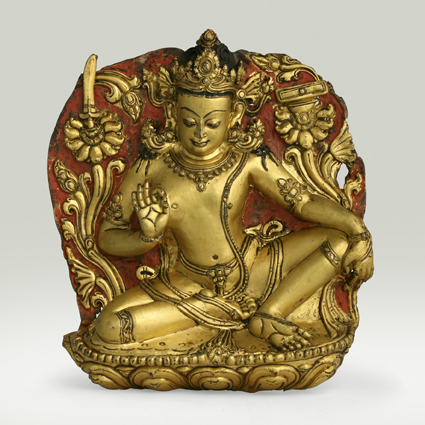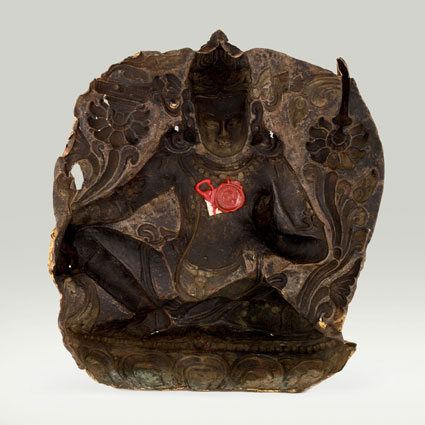ABS 145
Code: ABS 145
Country: Tibet
Style: Nepalese School
Date: 1250 - 1350
Dimensions in cm WxHxD: 24.1 x 26.5 x ?
Materials: Gilt sheet of hammered copper
Made from one gilt sheet of hammered copper decorated with engraved ornaments.
The rear is painted with red lacquer and the hair with black pigment.
The gifted Newars have long been famous for their ability to fashion sheets of copper into a desired shape, which would then be fire gilt. For the manufacture of embossed images Tibetan patrons almost exclusively employed Nepalese craftsmen.
The Manjusri (Tib. 'Jam dpal bdyangs) is seated in the attitude of royal ease (rajalalilasana) on a single pedestal with a prominent beaded upper border. The right hand is lifted in the gesture of fearlessness (abhaya mudra) and the left hand is resting on the left knee. He is bedecked with princely ornaments, namely a three fold jeweled crown, a pair of earrings, a necklace with attached pendants, the "investiture with the beaded sacred thread" (ratnopavita), and one pair of bracelets at the wrists. Stalks of blue lilies (nilotpala) are growing up on both sides of Manjusri. The flower on the proper right side is surmounted by a sword (khadga), and the flower on the propper left side by a manuscript (pustaka). The sword and the manuscript are the classical attributes of Manjusri. The gifted Newar have long been famous for their ability to fashion sheets of copper into a desired shape, which would then be fire gilt. Embossing was traditionally done by different guilds of artisans than those which cast images, but occasionally they had to work together on certain projects. The shaping of metal by hammering considerably pre-dates the invention of casting. For the technique of embossing, only soft and malleable metals such as gold, silver, lead, and unalloyed copper were obviously suitable. It cannot be verified whether this object was made in Kathmandu valley and subsequently exported to Tibet, or whether it was made in Tibet by a Newar caftsmen.
(From Wikipedia, the free encyclopedia)
Manjushree, also written Manjushri, is the bodhisattva of keen awareness in Buddhism. A disciple of the historical Buddha Shakyamuni, he represents wisdom, intelligence and realisation, and is one of the most popular Bodhisattvas following Avalokitesvara (Ch: Guan Yin).
Together with Shakyamuni and fellow disciple Samantabhadra he forms the Shakyamuni trinity (Jp: Sanzon Shaka). Manjusri is one of the Eight Wisdom Bodhisattvas and one of the Japanese Thirteen Buddhas. In Tibetan Buddhism he sometimes is depicted in a trinity with Avalokiteshvara and Vajrapani.
Manjusri is mentioned in many Mahayana sutras, particularly the Prajnaparamita Sutras. The Lotus Sutra assigns him a paradise called Vimala, which according to the Avatamsaka Sutra is located in the east. His consort in some traditions is Saraswati. He is also sometimes called Manjughosha.
Within Tibetan Buddhism, Manjushri is a tantric meditational deity or Yidam, and considered a fully enlightened Buddha.
Manjusri Mantra
Chanting the Manjusri Mantra "Om Ah Ra Pa Tsa Na Dhih" is believed to enhance wisdom and improve one's skills in debating, memory, writing, explaining etc. "Dhih" is the seed syllable of the mantra and is chanted with greater emphasis.
A male Bodhisattva, he is depicted wielding a flaming sword in his right hand, representing his realisation of wisdom which cuts through ignorance and wrong views. The scripture supported by the flower held in his left hand is the Prajnaparamita, representing his attainment of ultimate realisation and Enlightenment. Variations upon his traditional form as Manjusri include Guhya-Manjusri, Guhya-Manjuvajra, and Manjuswari, most of which are Tantric forms associated with Tibetan Buddhism. The two former appearances are generally accompanied by a shakti deity embracing the main figure, symbolising union of form and spirit, matter and energy.
Manchu
According to legend Nurhaci, a military leader of the Jurchen tribes and founder of what became the Chinese imperial Qing Dynasty, believed himself to be a reincarnation of Manjusri. He therefore is said to have renamed his tribe the Manchu.
Yamantaka
Yamantaka (meaning “terminator of Yama i.e. Death”) is seen as a wrathful manifestation of Manjushri, the buddha of wisdom. Yamāntaka (Tibetan: Shinjeshe Wylie: Gshin-rje-gshed) is a Mahayana Buddhist yidam or iṣṭadevata of the Highest Yoga Tantra class in Vajrayana, popular within the Geluk school of Tibetan Buddhism.
Role in Nepalese Mythology
According to Swayambhu Purana, the Kathmandu Valley was once a lake. It is believed that Manjushri saw a lotus flower in the center of the lake and cut a gorge at Chovar to allow the lake to drain. The place where the lotus flower settled became Swayambhunath Stupa and the valley thus became habitable.
The Newars of the Kathmandu Valley, who adhere to both Buddhism and Hinduism, revere him as the Bodhisattva of Wisdom.
Cornu, Philippe , 2001. Dictionnaire Encyclopédique du Bouddhisme. Seuil.
de Mallmann, Marie-Thérèse, 1964. Étude iconographique sur Manjusri. Paris: École Française d’Extrème-Orient. References to the iconography of Manjusri
de Mallmann, Marie-Thérèse, 1975. Introduction à l'iconographie du tântrisme bouddhique. Paris: Adrien Mainsonneuve (Jean Maisonneuve successeur (1970). Pp. 250-257 - References to the iconography of Manjusri
Sèngué, Tcheuky, 2002. Petite Encyclopédie des Divinités et symboles du Bouddhisme Tibétain. Editions Claire Lumiere . Pp. 164 / 185-191
von Schroeder, Ulrich, 2010. Buddhist Sculptures of the Alain Bordier Foundation. Hong Kong: Visual Dharma Publications, Ltd.. Pp. 32–33; plate 13A



